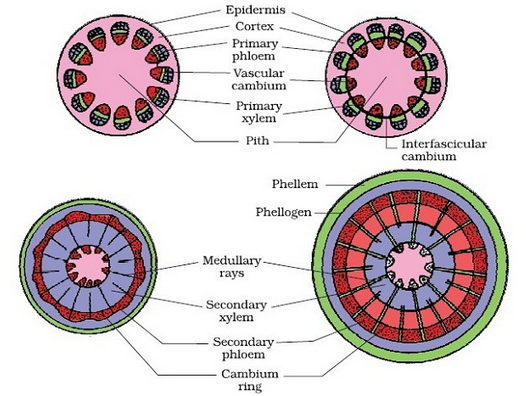
Secondary growth
- Meristem is responsible for the development of primary plant body.
- Primary growth increases length of the plant as well as lateral appendages.
- However, secondary Grier increases thickness or girth of the plant by the formation of secondary tissues.
- There secondary tissues are formed by the two types of lateral meristem i.e. vascular cambium and cork cambium (phellogen).
- Secondary growth occurs in stem and root of dicots and gymnosperms.
- However, it is absent in stem and root of monocot and completely absent in leaf.
- A process of formation of secondary tissues due to activity of vascular cambium and cork cambium for increasing thickness or girth or diameter of plant is termed as secondary growth.
- On the basis of the activities of vascular cambium and cork cambium, the process of secondary growth can be discussed under the following headings:
- Activity of the vascular cambium
- Activity of the cork-cambium

Secondary growth in stellar region due to activity of the vascular cambium
i. Formation of cambium ring:
- In vascular bundles of a dicot stem, the cambium is present in between the xylem and phloem. It is known as intrafascicular cambium.
- During secondary growth, some cells of medullary rays become active and show meristematic activity which form a strip of cambium in between vascular bundles called inter-fascicular cambium.
- Both the intra-fascicular and inter-fascicular cambium unite together to form a complete ring called the cambium ring.
- The activity of the cambium ring gives rise to secondary growth.
ii. Formation of the secondary tissues:
- The cambium ring acts as a meristem which divides.
- The cambium layer consists of a single layer of cells.
- These cells divide in a direction parallel with epidermis.
- A cambial cell divides into two daughter cells, one of which remains meristematic and other differentiates into secondary vascular tissue.
- The cell formed towards inner side develops into secondary xylem.
- Likewise, the cell formed towards outer side develops into secondary phloem.
- Normally, more secondary xylem cells are formed towards the center due to which cambium ring moves towards the periphery.
- Due to the formation of secondary xylem and secondary phloem, the primary xylem and primary phloem which were initially closed, moves towards inner and outer side respectively.
- As a result, they become separated apart.
- The layers of secondary tissues gradually added to the inner and outer side of the cambium continuously throughout the life of the plant.
iii. Formation of secondary medullary rays:
- Certain cells of the cambium instead of forming secondary xylem and phloem for some narrow bands of living parenchyma cells.
- These form two or three layers of thick radical rows of cells passing through the secondary xylem and secondary phloem and are called secondary medullary rays.
- These provide the radial conduction of food from the phloem, and water and mineral salts from the xylem.
iv. Formation of annual rings:
- The activity of cambium is affected by variations in temperature.
- In moderate climate, the cambium becomes more active in the spring and forms greater number of vessels with wider cavities, whereas in winter it becomes less active and forms narrower and smaller vessels.
- The wood formed in the spring is known as spring wood or early wood and that formed in the dry summer or cold winter is autumn wood or late wood.
- These two kinds of wood appear together as a concentric ring known as the annual ring or growth ring, as seen in transection of the stem and successive annual rings are formed year after year by the activity of the cambium.
- The growth of the successive years appears in the form of concentric or annual rings, each annual ring representing the one year’s growth.
- The age of the plant thus, can be approximately determined by counting the number of annual rings.
v. Formation of heart wood and sap wood:
- In the old trees, where sufficient amount of secondary growth has taken place, the secondary wood of inner side lose the power of conduction.
- Their cells get filled with tannins, resins, gums, essential oils which makes the plant part hard and darker called the heart wood or duramen.
- The heart wood ceases the function of conducting tissue and simply provides mechanical support to the stem.
- However, the outer region of secondary wood, which consists of younger living xylem cells, remains yellow in colour called the sap wood or laburnum.
- It functions as the conducting tissue and also as the food storage tissue.
Secondary growth in extra stellar region due to activity of cork-cambium:
- The marked increase in diameter or thickness of stem brought about by the secondary thickening exerts a great pressure on the outer tissues.
- This results in the rupture of the cortex and epidermis, the outer cortical cells become meristematic and begins to divide. This is known as cork cambium or phellogen.
- The cork cambium divides to form secondary tissue on both the sides i.e. internal and external but its activity is more on the outer side than on the inner side.
- The cells formed on the outer side constitutes the phellem or cork and those on the inner side form secondary cortex or phelloderm.
- The phellogen, phellem and phelloderm together are called periderm.
